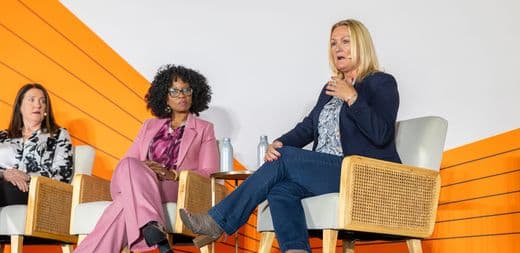Sarah Beldo |
It’s easy to champion innovation in stable times. You have the luxury of trying out new people-focused programs and ideas. But conventional wisdom suggests that in less certain times, a company’s appetite for experimental HR initiatives would be lower.
Or is it actually the other way around? Many experts predict 2024 will be a tumultuous year, but Guild’s latest research reveals that 93% of business leaders are eager for HR to bring innovative solutions to the table.
What’s top of mind for business leaders
So where to focus? In December 2023, we surveyed 266 business leaders at companies with 1000+ employees to find out how they feel about their partnership with HR, and how talent strategy impacts their business-critical goals.


You can use our findings to start charting your game plan for the coming months. Aligning with business priorities and outcomes is an imperative for HR leaders to meet the expectations of modern organizations—particularly with a year ripe for so many challenges, both known and unknown.
Attracting talent is the most urgent priority
Despite headlines about the pace of hiring slowing down, attracting talent was the most-cited HR-related concern in our study. An overwhelming 97% of leaders view attracting talent as a priority in 2024, with 69% of respondents labeling the need as “urgent.”
As companies feel pressure to fill open roles, there are tailwinds that make the issue more acute: a record number of Baby Boomers are set to leave the workforce over the next 5 years, and research from Glassdoor shows that Generation Z are slated to surpass Boomers in the workforce this year.
The concerns arising from this trend are twofold. For one thing, 82% of leaders are concerned about losing institutional knowledge as workers retire. But at the same time, there’s also a need to quickly adapt your employer value proposition for a new generation. A total of 73% of leaders are concerned about meeting the expectations of Gen Z.
"I think HR needs to re-think and re-evaluate the mentality and expectations of young workers who are not just motivated by money anymore. They need continuous learning, good work-life balance, and a satisfying career."
Director of Cloud Operations in the Professional Services industry.
Innovation opportunity: Make career growth the heart of your EVP
Compensation and flexibility are undoubtedly important for catching the eye of prospective candidates, but today’s workers want companies to invest in them.
Nearly 9 out of 10 say that when they’re job hunting, they are looking for an employer with career advancement opportunities and ways for them to progress. And 2022 Guild research reveals 74% of workers said they would be somewhat or very likely to leave for a new role if it offered additional education or career opportunities.
That means the opportunity is ripe to differentiate your company from the rest of the pack by providing true career mobility opportunities—and being loud and proud with your offerings.
The Walt Disney Company is a powerful example of putting this approach into action: 1 out of 4 people who apply to work at the company cite Disney Aspire—a program that covers 100% of tuition costs for education—as the reason they applied.
Don’t deprioritize employee experience
For the past few months, data has shown that the "quit rate" is the lowest it has been in years and more employees are staying in jobs. And because of that trend, analysts have been raising the possibility of an “employee experience winter,” where EX-focused programs fall victim to cost-cutting measures because companies are less concerned about losing their people.
But these headlines can be incredibly deceiving. Our survey shows retention is still very much top of mind: 67% of business leaders say retaining top talent is an urgent priority this year.
And a massive 81% of leaders are concerned about losing top performers who are unengaged. Can you really afford to cut back on the programs that power your people’s job satisfaction?
Employees want to stay with companies who take a holistic approach to caring for people. And with burnout still a major risk, caring for the whole employee is critical.
Research consistently shows that lack of access to learning and growth are some of the main reasons people leave their jobs, and that investing in training increases retention. Continuous learning programs should have a holistic approach, addressing the entire lifecycle of employees, from hire to promotion—and beyond.
"I would love to see programs that can build on each other, with a foundation for newer team members and in-depth learning for seasoned workers."
Daryl, VP of Procurement Operations in the food services industry
Innovation opportunity: Double down on championing people-first programs
Our research identified that business leaders have urgent HR needs and also crave innovation. Now it’s time to connect the dots to make sure people-first programs are prioritized.
If DE&I, mental health benefits, and L&D programs are on the chopping block, it’s up to HR to step up and advocate for these initiatives, clearly showing how they contribute to both employee satisfaction and business goals and outcomes.
To do this effectively, you’ll need two sets of data: what’s most important to employees, and what’s most important to stakeholders. Start by finding out what really matters to both of these groups through focus groups, interviews, and surveys. The more you can target your data to show the true impact of your programs, the better.
[Check out our guidance how to choose the right skilling metrics.]
Continuous skilling to stay ahead
Upskilling and reskilling initiatives are gaining importance as trends like generative AI, the global energy transition, and disruptive technologies gain steam. More than half (53%) of respondents see skills readiness as an urgent imperative for 2024.
And 71% are specifically concerned with their workforce not having the skills to leverage AI. This is understandable, given how quickly the need for generative AI know-how has sprung up. And surveys show that the majority of employees are already using this technology, with or without formal training.
With so much at stake, leaders are hungry for new solutions to familiar and emerging skilling issues.
"HR should design an upskill program to promote from within, helping to maintain our culture throughout new departments and positions."
James, an IT Director in the Manufacturing industry
William, a Director of IT in the retail industry, wrote: "I would like to see HR focus their hiring on knowledge-based criteria instead of university based learning criteria.”
His thoughts echo a wider trend of skills-based hiring when it comes to sourcing talent. But skills-based hiring is rarely enough on its own. Too many times, internal talent is left behind, with no clear way to attain these crucial skills.

Innovation opportunity: Pair skills with career pathways
An approach that focuses on skills alone often falls short of meeting the needs of the employee—and the business.
Instead, pair skills with a clear articulation of career pathways. Show employees how they can grow, give them access to project-based learning and relevant nearer-term certifications. Outline exactly what steps they need to take to get them into high-demand positions.
This creates a powerful dynamic to hire from a wider pool of people, bolster DE&I efforts, attract a new generation who has different expectations, and build a pipeline of the skills needed for the future.
For example, Bon Secours Mercy Health created an innovative internal mobility framework, which enables them to hire entry-level people with no prior experience and give them the targeted support to help them grow into (often higher-paying) in-demand roles. Each functional area has an internal mobility partner assigned to them, and employees with an interest in a particular area will get training, coaching, and guidance at every step.
Paving the way forward
With connections to so many departments across the organization, you may feel like you’re already clear on company priorities. But a new year offers new opportunities to re-evaluate what’s most crucial for your business partners to succeed—and focus your efforts there.
Despite a legacy perception that HR isn’t a business-critical function, our survey revealed that cross-functional stakeholders want an even tighter feedback loop with their HR partners. Some 85% confirmed that a closer relationship with HR would help them achieve their goals.
The upshot? To make an impact in 2024, HR leaders should act with increased urgency and confidence to reach out to your partners across the organization, ask questions, listen, and think big. It’s time to lean in.



